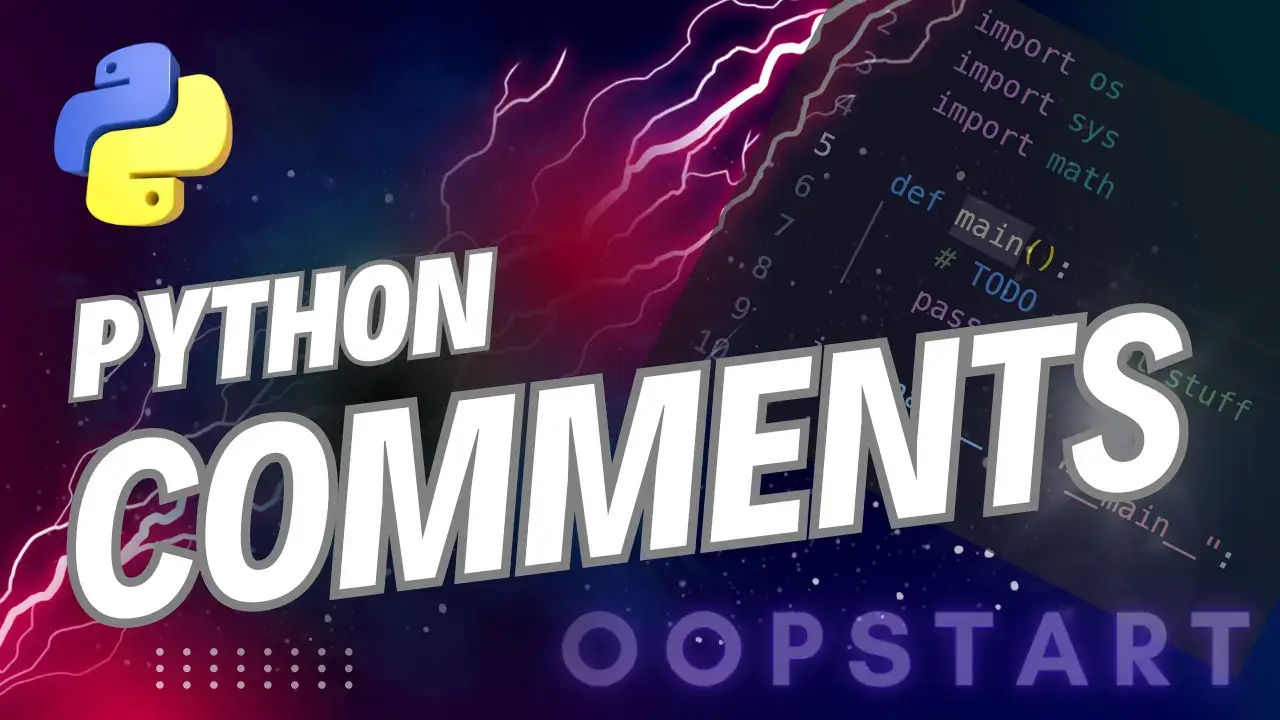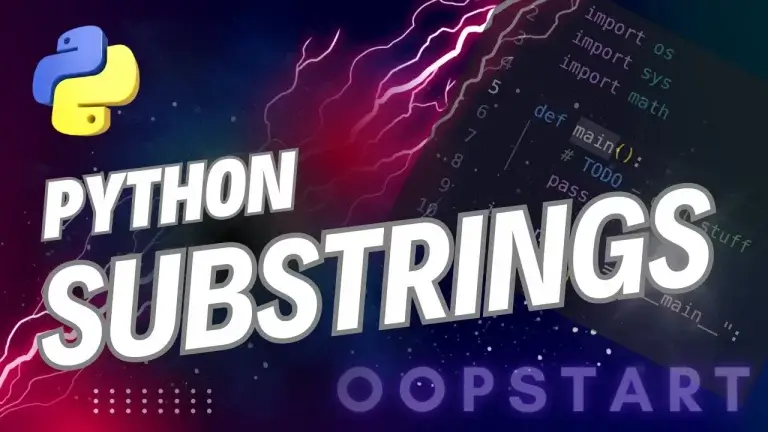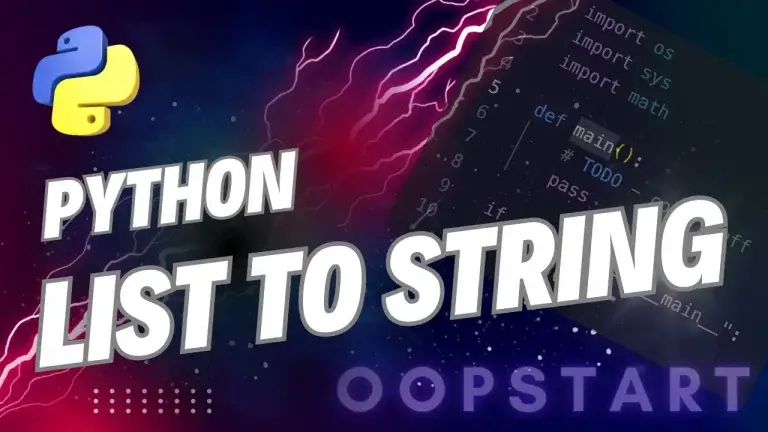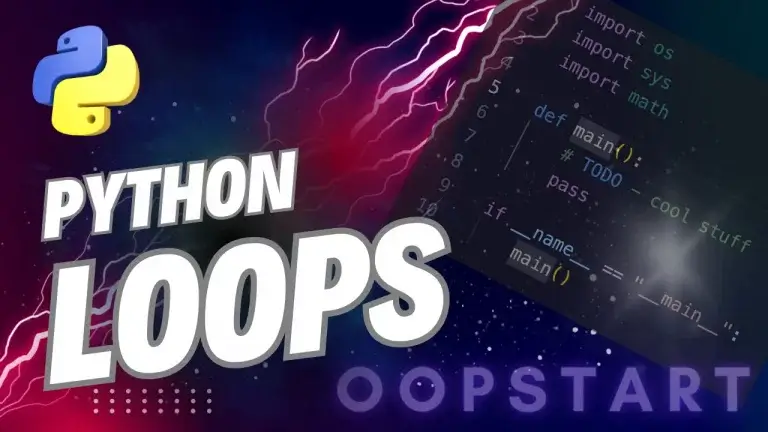Comment in Python: A Complete Guide
When writing Python code, it’s essential to ensure that your code is not only functional but also readable and maintainable. One of the most effective ways to enhance the clarity of your code is by using comments. A comment in Python is a note or explanation written in the code that is ignored by the Python interpreter.
This means comments do not affect the execution of the program but help developers and collaborators understand the code’s logic, purpose, or any complex sections.
Table of Contents
What is a Comment in Python?
A comment in Python is any text within a Python program that is preceded by a hash symbol (#). Python ignores these lines when executing the code, making them purely for humans to read.
Basic Syntax:
# This is a comment
Example:
# This is a simple Python program to add two numbers
a = 10 # Assign 10 to variable 'a'
b = 5 # Assign 5 to variable 'b'
result = a + b # Add 'a' and 'b'
print(result) # Output the result
In this example, all the text following the # symbol is a comment and will not affect the program’s execution.
Why Are Comments Important?
Comments in Python serve several important purposes:
- Code Readability: Well-placed comments help explain the logic behind code, making it easier for others (and yourself) to understand your program, especially when revisiting it after some time.
- Debugging: Comments can be used to temporarily disable code during debugging without deleting the lines.
- Collaboration: In team-based projects, comments help team members understand various sections of code, reducing the learning curve.
- Documentation: Comments help document functions, methods, and complex sections of code, providing context and explaining what the code is doing.
Types of Comments in Python
There are two main types of comments in Python:
- Single-line comments
- Multi-line comments
1. Single-Line Comment in Python
A single-line comment begins with a hash symbol (#). Everything following the # on that line is ignored by the Python interpreter.
Example:
# This is a single-line comment
x = 10 # This is another comment next to code
In this example, the comment "This is a single-line comment" is ignored, and the code continues to execute normally.
2. Multi-Line Comment in Python
Python does not have a specific syntax for multi-line comments like some other programming languages. However, there are two commonly used methods for writing multi-line comments in Python:
- Using multiple single-line comments.
- Using docstrings (for documentation purposes).
Method 1: Multiple Single-Line Comments
The simplest way to write a multi-line comment is by using multiple single-line comments, each beginning with #.
Example:
# This is a multi-line comment
# Line 2 of the comment
# Line 3 of the comment
Method 2: Using Docstrings for Multi-Line Comments
A docstring is a string literal that appears as the first statement in a function, class, or module. While docstrings are primarily used for documentation, they can also serve as multi-line comments. Docstrings are written between triple quotes (''' or """), and Python treats them as documentation rather than comments, but they are ignored during execution unless explicitly accessed.
Example:
"""
This is a multi-line comment using a docstring.
It spans multiple lines, and Python will ignore it
unless accessed through the __doc__ attribute.
"""
print("Hello, World!")
Output:
Hello, World!
In this case, the docstring serves as a multi-line comment, though its primary use is for documenting functions, methods, or classes.
Commenting Multiple Lines in Python
As Python does not have a dedicated multi-line comment syntax, you can either use multiple single-line comments or docstrings. However, for longer sections of code, using multiple single-line comments is often preferred for clarity.
Example:
# This is a multi-line comment
# that spans multiple lines
# using the hash symbol.
Alternatively, if you’re using an IDE or text editor, you can often select multiple lines of code and use a keyboard shortcut to comment or uncomment them all at once. For example:
- VS Code:
Ctrl + /(Windows) orCmd + /(macOS). - PyCharm:
Ctrl + /(Windows) orCmd + /(macOS).
Commenting Best Practices in Python
To write clear and helpful comments in Python, follow these best practices:
1. Keep Comments Relevant and Updated
Comments should always reflect the current state of the code. Outdated or incorrect comments can lead to confusion. Make sure to update comments whenever the corresponding code is changed.
Example (Good Practice):
# Function to calculate the square of a number
def square(num):
return num * num
2. Avoid Redundant Comments
Don’t write comments that are obvious or redundant. Comments should explain why the code does something, not what it does (which should be clear from the code itself).
Example (Bad Practice):
x = 5 # Assign 5 to x
y = 10 # Assign 10 to y
In this example, the comments don’t add any value because the code itself is already self-explanatory.
3. Use Proper Grammar and Spelling
Well-written comments with correct grammar and spelling enhance readability and professionalism. Even though comments are not executed, they should maintain the same quality as the code.
Example:
# Calculate the total cost after applying the discount
def calculate_discount(price, discount):
return price - (price * discount)
4. Use Comments to Explain Complex Logic
If a particular section of code has a complex algorithm or logic, add a comment that explains how it works.
Example:
# The loop iterates over each element in the list and checks if it is prime.
for num in range(2, 100):
is_prime = True
for i in range(2, num):
if num % i == 0:
is_prime = False
break
if is_prime:
print(num)
5. Document Functions with Docstrings
Use docstrings to document the purpose, arguments, and return values of functions and classes. This helps other developers understand the usage of your code.
Example:
def add_numbers(a, b):
"""
Adds two numbers and returns the result.
Args:
a (int or float): The first number.
b (int or float): The second number.
Returns:
int or float: The sum of a and b.
"""
return a + b
Inline Comments in Python
An inline comment is a comment that appears on the same line as the code. It is placed after the code and separated by at least two spaces.
Example:
x = 10 # Assign 10 to x
y = x + 5 # Add 5 to x
Inline comments should be used sparingly and only when the code requires a quick explanation.
Using Comments for Debugging in Python
One common use of comments during the development process is for debugging. You can temporarily “comment out” lines of code to prevent them from executing, allowing you to isolate problematic sections or test different behaviors.
Example:
x = 10
y = 5
# print(x + y) # This line is commented out for debugging
print(x * y) # Only this line will execute
By commenting out the print(x + y) line, you can test how the code behaves without that particular statement.
Comments and Python Documentation
In Python, docstrings (triple-quoted strings) are used for documenting functions, classes, and modules. They can be accessed programmatically using the __doc__ attribute. Docstrings are a critical part of creating readable and well-documented Python code, especially when building libraries or APIs.
Example:
def greet(name):
"""
Greets the user with the provided name.
Args:
name (str): The name of the user.
Returns:
str: A greeting message.
"""
return f"Hello, {name}!"
Accessing the Docstring:
print(greet.__doc__)
Output:
Greets the user with the provided name.
Args:
name (str): The name of the user.
Returns:
str: A greeting message.
Docstrings are an important part of Python’s documentation tools, such as Sphinx and Pydoc, which can automatically generate documentation from the docstrings in your code.
Comment in Python: Key Takeaways
- A comment in Python begins with a
#symbol and is ignored by the interpreter. - Python supports both single-line comments and **multi-line comments
** (via multiple # or docstrings).
- Comments improve code readability, maintainability, and help with debugging.
- Use docstrings to document functions, classes, and modules.
- Follow best practices when writing comments to ensure they are relevant, helpful, and easy to understand.
Exercise:
- Single-Line Comments: Write a Python program that uses single-line comments to explain each step of a function that calculates the factorial of a number.
- Multi-Line Comments: Use multi-line comments to explain the logic behind a complex loop that prints all prime numbers between 1 and 100.
- Docstrings: Write a Python function that takes two arguments (a name and age) and returns a formatted string. Use a docstring to document the function, including the parameters and return value.
Check out our FREE Learn Python Programming Masterclass to hone your skills or learn from scratch.
The course covers everything from first principles to Graphical User Interfaces and Machine Learning
You can check out more info about Python in the official Python documentation.
FAQ
Q1: What is the purpose of a comment in Python?
A1: A comment in Python is used to explain or annotate the code, making it more readable and understandable for humans. Comments are ignored by the Python interpreter during execution, so they don’t affect the program’s functionality. They help other developers understand the purpose, logic, or structure of your code.
Q2: How do I write a single-line comment in Python?
A2: To write a single-line comment in Python, start the comment with a # symbol. Everything after the # on that line will be treated as a comment and ignored by Python.
Example:
# This is a single-line comment
x = 10 # Comment next to code
Q3: How do I write a multi-line comment in Python?
A3: Python doesn’t have a dedicated multi-line comment syntax, but you can create multi-line comments in two ways:
- Use multiple single-line comments:
# This is a multi-line comment
# that spans multiple lines.
- Use a docstring with triple quotes (
'''or"""):
"""
This is a multi-line comment
that spans multiple lines.
"""
Docstrings are typically used for documentation but can also serve as multi-line comments.
Q4: What’s the difference between a comment and a docstring in Python?
A4:
- A comment starts with
#and is ignored by Python during execution. It is used to explain parts of the code. - A docstring is a string literal (enclosed in triple quotes) that appears at the beginning of a function, class, or module. Docstrings are intended for documentation purposes and can be accessed programmatically using the
__doc__attribute.
Example of a docstring:
def my_function():
"""
This is a docstring.
It explains what the function does.
"""
pass
Q5: Can I comment out multiple lines of code at once?
A5: Yes, you can comment out multiple lines of code by:
- Adding
#at the beginning of each line. - Using a keyboard shortcut in your IDE or text editor:
- VS Code:
Ctrl + /(Windows) orCmd + /(macOS). - PyCharm:
Ctrl + /(Windows) orCmd + /(macOS).
This will toggle comments on or off for all selected lines.
Q6: Should I use comments to describe every line of code?
A6: No, it’s generally not recommended to comment on every line of code, especially when the code is self-explanatory. Comments should be used to explain why something is done, not what is being done (the code should already be clear about that). Over-commenting can make the code cluttered and harder to read.
Q7: How do I write a good comment in Python?
A7: To write a good comment:
- Keep it concise and relevant: Explain the purpose or logic of the code, not obvious details.
- Keep it up-to-date: Ensure your comments reflect any changes in the code.
- Use proper grammar and spelling: Well-written comments enhance code professionalism.
- Avoid redundancy: Don’t state what the code is already explaining clearly.
Q8: What’s the best way to document a function in Python?
A8: The best way to document a function is by using a docstring. Place the docstring immediately after the function definition to explain what the function does, its parameters, and its return value.
Example:
def add(a, b):
"""
Adds two numbers and returns the result.
Args:
a (int or float): The first number.
b (int or float): The second number.
Returns:
int or float: The sum of a and b.
"""
return a + b
Q9: Can comments be used for debugging in Python?
A9: Yes, comments are often used to “comment out” code temporarily during debugging. This allows you to prevent certain lines of code from running without deleting them.
Example:
x = 10
y = 20
# print(x + y) # Commented out for debugging
print(x * y) # This line will execute
Q10: Are comments included in the final output or execution of a Python program?
A10: No, comments are completely ignored by the Python interpreter and do not affect the execution or output of the program. They exist solely for developers and do not get processed by the interpreter.
Q11: Can I add comments next to code on the same line?
A11: Yes, you can add inline comments by placing the comment after the code on the same line.
Example:
x = 10 # This is an inline comment
Inline comments should be used sparingly and only when necessary to explain specific parts of the code.
Q12: How can I access the docstring of a function?
A12: You can access the docstring of a function using the __doc__ attribute.
Example:
def my_function():
"""
This is a docstring.
"""
pass
print(my_function.__doc__)
Output:
This is a docstring.
Q13: What happens if I don’t use comments in my code?
A13: While your code will still run without comments, it will be harder for others (and even yourself) to understand, especially if it’s revisited after a long period. Comments improve code readability and maintainability, making collaboration easier and troubleshooting faster.
Q14: How do I comment Python code in an IDE like VS Code or PyCharm?
A14: Most modern IDEs, such as VS Code or PyCharm, allow you to comment and uncomment lines of code using keyboard shortcuts:
- VS Code:
Ctrl + /(Windows) orCmd + /(macOS). - PyCharm:
Ctrl + /(Windows) orCmd + /(macOS).
Simply select the lines of code and use the shortcut to toggle comments on or off.
Q15: Can comments slow down my Python program?
A15: No, comments do not affect the performance of your Python program. Since comments are ignored by the Python interpreter, they have no impact on the execution speed or performance of your code.








